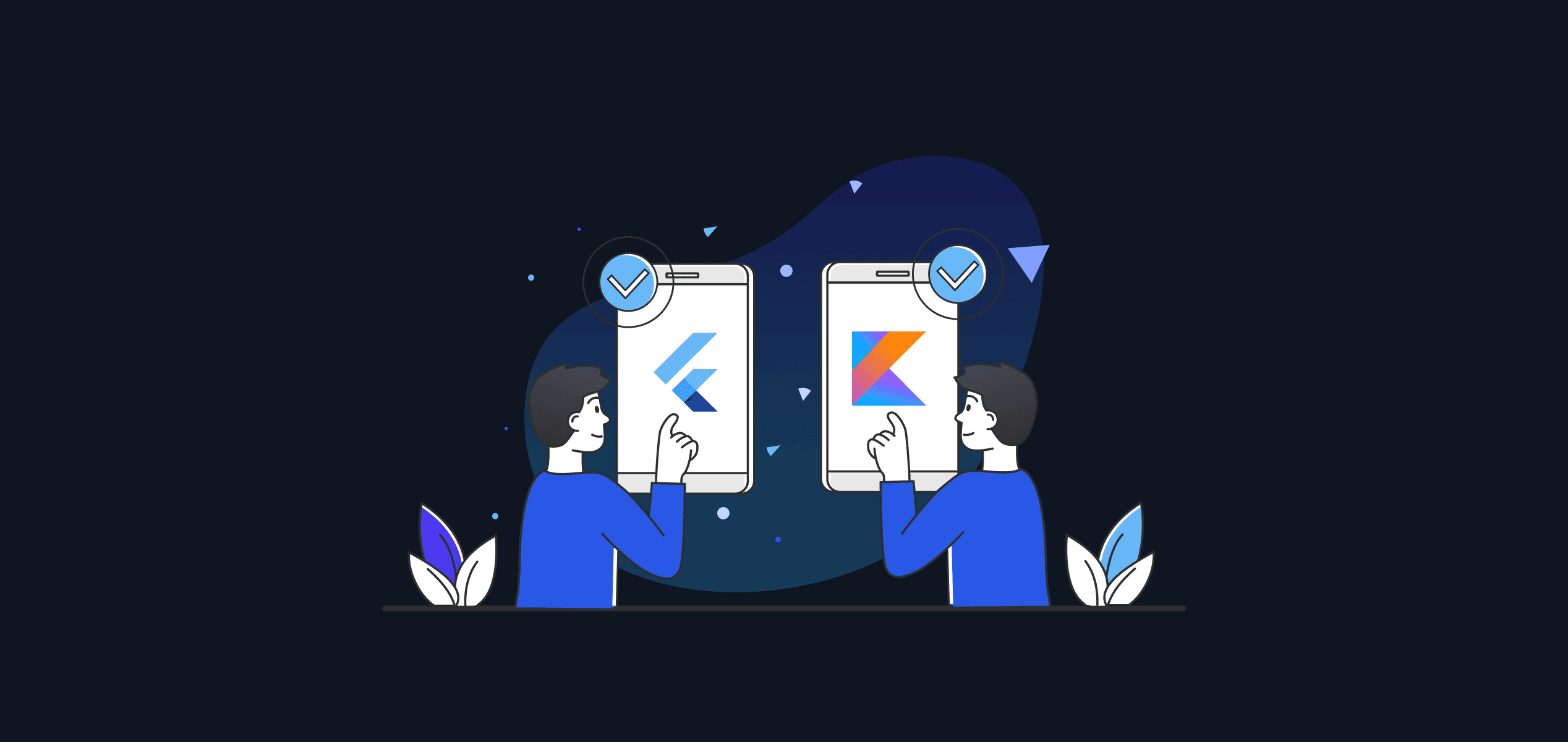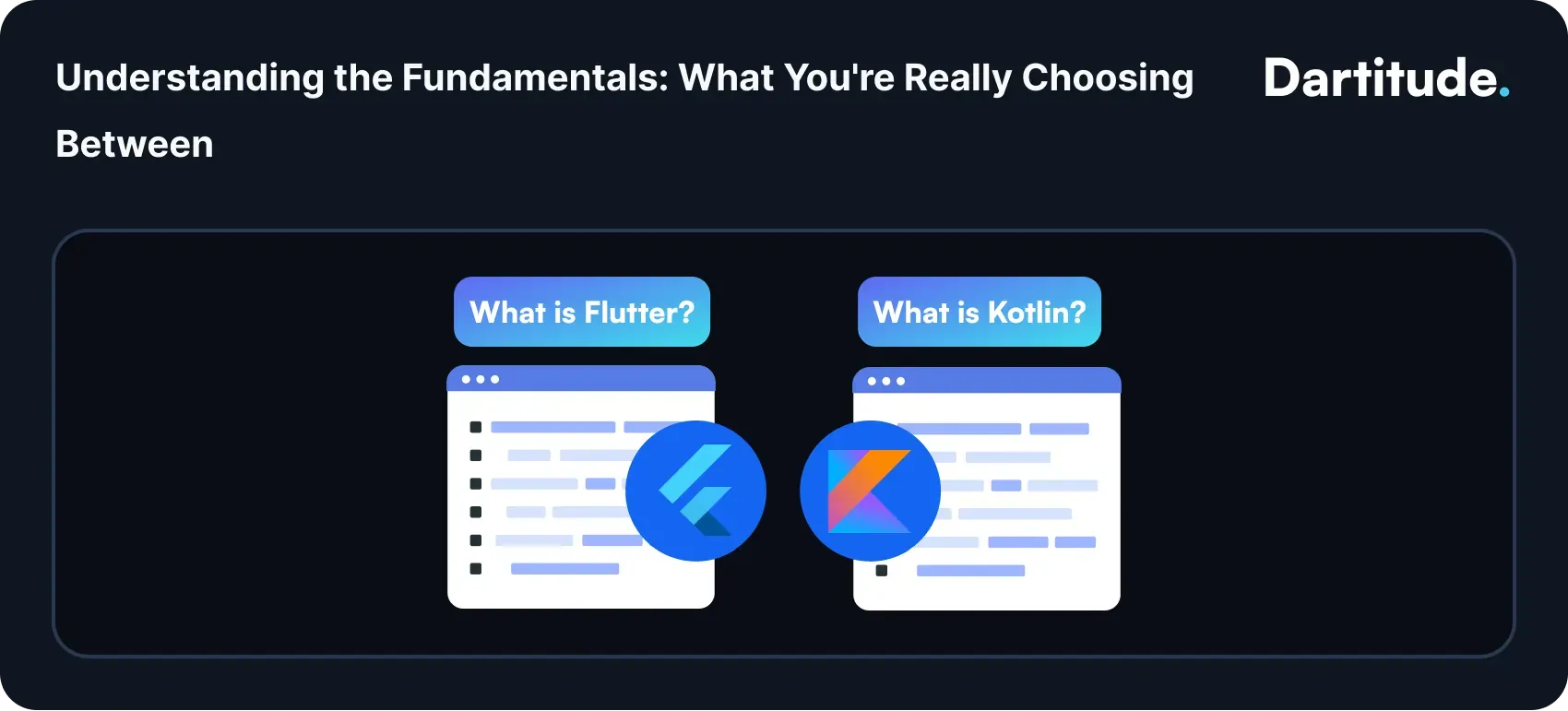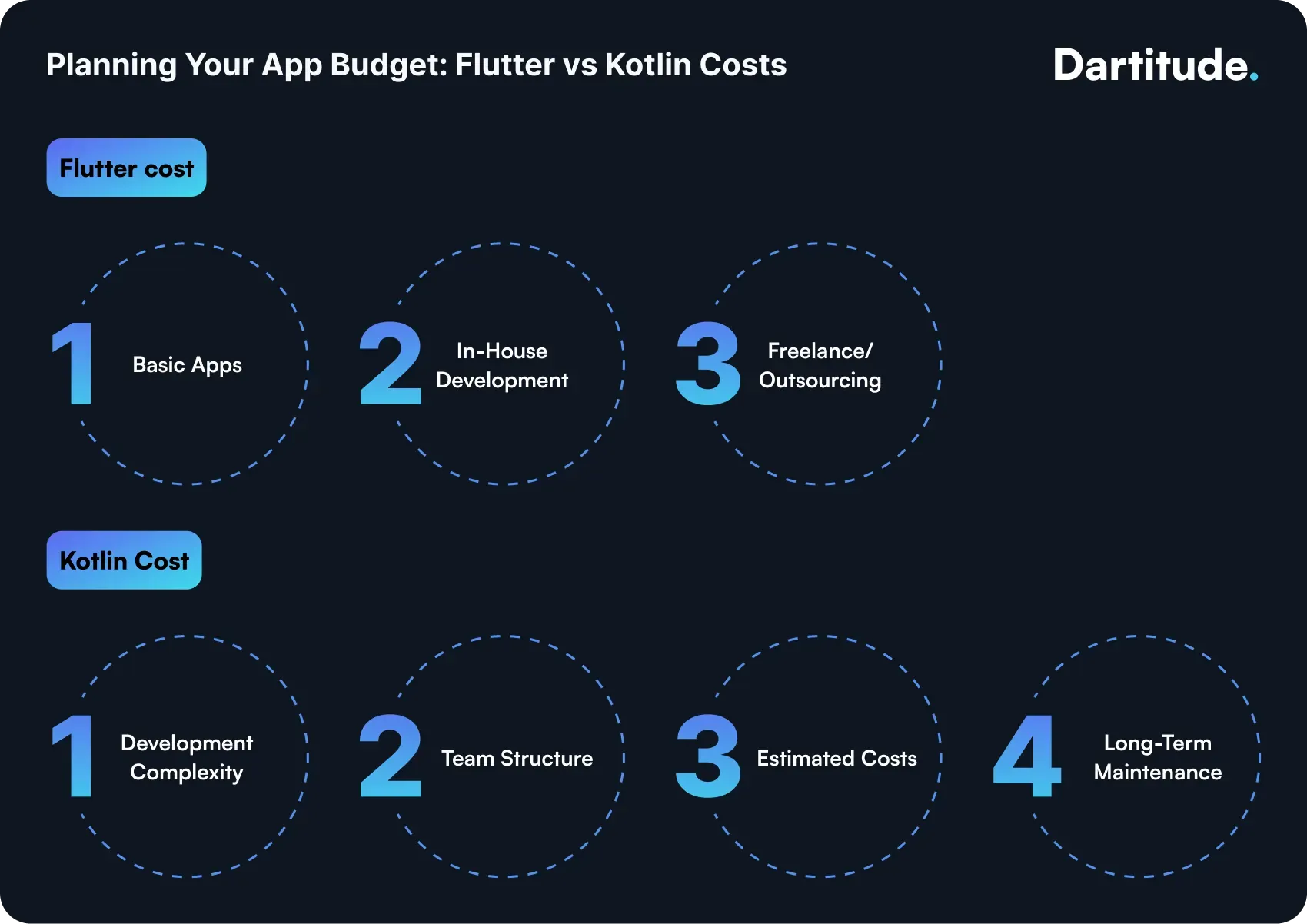
Flutter or Kotlin Multiplatform in 2025: Which Framework Wins for Modern App Development?
Last month, I was giving a session to a startup team that had everything planned as per task allocation; a strong concept, funding, and a clear vision. But they had a question in their mind:
Flutter or Kotlin Multiplatform, which one is better?
It’s a question I hear every time. Although both frameworks deliver better flexibility and native-like performance, selecting the wrong one can increase your overhead cost.
In 2025, this debate isn’t just about tools; it’s about choosing the right foundation for your future-ready app. Let’s break down what truly is important.
Understanding the Fundamentals: What You're Really Choosing Between

Companies today still make wrong decisions about selecting mobile app development frameworks - Flutter or Kotlin. If you’ve ever wondered “Flutter vs Kotlin, which is better?”, understanding the fundamentals below will help you make an informed, strategic decision for your cross-platform app development journey
What is Flutter?
Flutter, which is a cross-platform framework, utilized mostly for developing mobile apps, uses the Dart programming language, enabling developers to build natively compiled mobile and web applications with a single codebase. Almost 46% of developers globally utilize Flutter, making it the most popular cross-platform mobile framework.
What is Kotlin?
Kotlin, a modern programming language that was developed by JetBrains in 2016, was officially adopted by Google as the main language for Android development in 2019. With Kotlin, you can easily integrate the KMP module by module into an existing native app instead of building it from scratch.
Key Note: It was recorded in 2025, Kotlin Multiplatform (KMP) has surged to a 23% market share, up from 12%, while Flutter keeps its robust presence with a 42% share in cross-platform development.
Flutter vs Kotlin: Pick the Right Framework for Your Project

Are you still confused about which one to prefer for app development? Let me help you to critically evaluate the major differences between these two frameworks:
When Flutter is the Smart Choice
Let me show you why to use Flutter and how it remains the smartest choice for building modern, high-performance apps that work seamlessly across platforms.
1. Fast Time-to-Market
With the strong feature of a single code base, going with Flutter is the best option as it ultimately minimizes the development time and launches your app faster in comparison to native alternatives.
2. UI-Intensive Applications
If you are planning to build apps that require rich interfaces, such as e-commerce, content platforms, widget library with animations. Then, Flutter can offer you UI rich key features which are crucial for your app.
3. Small, Agile Teams
Having a small team with expertise in iOS and Android development simultaneously? Flutter is the prominent option you can think of, as it allows you to minimise the overhead and costs and simplifies the process of project management, better for organisational growth.
4. Consistent Branding
As Flutter is the single codebase providing a unified experience, apps built with Flutter are identical across all platforms. This further reflects brand consistency and well well-maintained across all user touchpoints.
5. Budget-Friendly
Due to its sharing of a single codebase, Flutter minimizes the development cost in contrast to having separate native teams. High-quality results could be achieved with low investment, beneficial for startups and mid-scale enterprises.
When Not to Use Flutter
Building applications with a strong focus on complicated hardware and software integration, such as AR/VR or advanced sensors, then I would suggest not choosing Flutter.
When Kotlin Multiplatform is the Smart Choice
 It’s ideal for teams aiming to maximize code reuse without compromising native performance. Let's see below how Kotlin can be used smartly:
It’s ideal for teams aiming to maximize code reuse without compromising native performance. Let's see below how Kotlin can be used smartly:
1. Existing Native Apps
If you’re looking to expand your Android codebase to support iOS, apps built with Kotlin are a smart choice. It enables you to use a large amount of data from your existing codebase, eliminating the redevelopment time and reducing project risk.
2. Performance-Critical Applications
Yes, you heard it right. When coming up with the idea of developing a mobile app, if it needs heavy computational tasks, real-time processing, then it can benefit from KMP. Through native compilation, your app could achieve higher speed, effectiveness, and credibility.
3. Platform-Specific Features
If the app relies on iOS or Android-based functionalities, KMP keeps the complete platform fidelity. It allows users to enjoy the native experience on every platform without any compromise of quality.
4. Separate Development Teams
KMP supports independent iOS and Android teams while enabling shared business logic. This effective approach is suitable for larger teams and enterprise-scale projects.
5. Enterprise-Scale Projects
Kotlin supports large-scale projects, offers long-term scalability, and its high-end architecture guarantees scalability and stability.
When Not to Use Kotlin Multiplatform
Avoid using KMP as it may slow down your MVP or the launch of an app due to separate UI development for each platform.
If you want to want to have advanced UI with rich key features, then Flutter wins the race.
Real-World Performance Comparison: Flutter vs Kotlin Multiplatform in 2025
Now, I’ll show you how Flutter and Kotlin Multiplatform perform in a real-world case, so that you can make the correct decision while choosing the right framework:
| Feature | Flutter | Kotlin Multiplatform |
| UI Animations | Smooth, 60–120 fps | Native, smooth |
| Startup Time | 2–3 sec | Comparable, native speed |
| Memory Usage | Slightly higher | Optimized for each platform |
| Battery Consumption | Slightly higher for heavy UI | Native efficiency |
| Complex Computation | Flutter easily handles the complex computational tasks flawlessly | Superior for AR/VR, real-time processing |
| Multi-Platform Module Sharing | Single codebase across iOS, Android, and Web | Share business logic while keeping native UI |
| Testing & Debugging | Hot reload, built-in unit and widget tests | Native unit tests, integration with existing CI/CD pipelines |
| Offline Support | Supports caching, SQLite, Hive | Native database integrations, advanced offline logic |
| Scalability | Good for startups and medium apps | Enterprise-grade scalability and modularity |
Verdict: If it is about building smooth, UI-intensive apps, then Futter is in the top position while Kotlin excels where native performance and platform-specific features matter most.
The Flutter vs Kotlin performance debate continues to evolve as technology improves worldwide, allowing developers to select based on project goals and scalability requirements.
Flutter vs Kotlin Multiplatform: Advantages and Limitations
Both frameworks are best in their own environment, and that is why it is essential to analyze the advantages and disadvantages for better decision-making making choosing a framework:

Advantages of Flutter
It is important to critically understand the Flutter benefits and limitations so that we can make the right decision ahead:
1. Cross-Platform Efficiency
The efficiency level of Flutter is relatively higher in comparison to Kotlin. This is because it removes the process of writing code for an entirely new app. With a single code base feature, you will get a unified experience that will save your cost and time.
2. Fast Development with Hot Reload
With this feature of hot reload, Flutter allows quick updates during the time of development process. Developers can see code changes in real-time, making UI faster.
3. Consistent and Beautiful UI
Flutter guarantees a unified and pixel-perfect design across all platforms as it offers you widgets and a wide variety of libraries. Moreover, consistency is well maintained across different devices, and you are able to receive smooth interfaces.
4. Rich Ecosystem and Community Support
Yes, Flutter has thousands of pre-built packages and plugins. The feature integration from database management to animations and cloud connectivity becomes simpler and is supported by large developer communities.
5. Lower Initial Development Cost
When using Flutter, you do not have to hire a separate developer team, as apps can run on a single codebase. It easily reduces your hiring cost in contrast to a native team.
Limitations of Flutter
Let me now discuss some common drawbacks of Flutter:
1. Higher Memory Footprint
Apps built with Flutter can be slower on low-end devices. Since they consume more RAM and storage space, it can direct impact on old smartphones.
2. Limited Native Feel (Without Customization)
If not customized properly as per platform-specific behavior or design guidelines, Flutter apps may not feel like native apps unless carefully optimized.
3. Complex Platform Integration
If apps need native functionalities such as NFC, AR, VR, or Bluetooth, in that case more code is required, making it a complex process for the developers.
4. UI Maintenance Overhead
Maintaining the UI consistency requires additional cost, as Flutter offers its own UI from scratch, providing full control. UI maintenance overhead cost could affect the development process.
Therefore, it is important to focus on high-quality Flutter app development services that can optimize costs efficiently.
Kotlin Multiplatform (KMP): Pros and Cons
Below are some of the key pros and cons of Kotlin Multiplatform that one should be aware of:

Advantages of Kotlin Multiplatform
1. True Native Performance
KMP provides performance similar to native apps due to its compiled approach of platform native code. This is beneficial for applications focusing on real-time analytics, performance-critical tasks, and computationally demanding tasks.
2. Shared Business Logic
Business logic can be shared, which means you can reuse the data layers, code, and networking across both iOS and Android. This, however, minimizes the potential bugs and boosts the updates.
3. Native-Looking User Experience
Native UI frameworks such as SwiftUI and Jetpack Compose are utilised by Kotlin, which ensures apps look native on every platform and adopt the design consistency naturally.
4. Gradual and Flexible Adoption
Yes, KMP could be easily integrated into existing apps. Teams could start from a small base, for example, sharing network code without writing the complete code for applications, reducing the risks.
5. Enterprise-Level Scalability
The modular architecture of KMP supports big and complex projects. The stability of Kotlin and its structure make it a perfect fit for enterprises looking to maintain long-term and multi-platform systems.
Limitations of Kotlin Multiplatform
1. Longer Initial Development Time
Kotlin requires an additional UI development team for Android and iOS. This can increase the cost of hiring, and more resources could be needed. It leads to delays in time during development phase.
2. Steeper Learning Curve
It is important to understand the architecture of KMP, considering iOS and Android frameworks simultaneously.
3. Smaller Ecosystem (But Growing Fast)
In comparison with Flutter, KMP offers a few third-party libraries and plugins. To enhance the ecosystem, or say community, developers have to write code for the libraries or components.
4. Specialized Team Requirements
Yes, for the UI implementation, the KMP project needs separate platform professionals. Even with shared business logic, UI work still needs skilled iOS and Android developers for the best results.
Planning Your App Budget: Flutter vs Kotlin Costs

Properly analyzing the development cost of several frameworks helps businesses plan budgets effectively, avoid unexpected events, and choose the most cost-efficient path for building high-quality mobile apps. Let me explain how costs differ when building apps:
Flutter cost
Flutter’s single codebase minimizes the development time and costs effectively. Selecting the correct cost structure can optimise your app development process even faster. Below is the cost variance of the Flutter framework:
1. Basic Apps
Basic apps, such as building calculators or note-taking apps, for such, the development cost can range from $8000 to $15,000. These projects usually take 2 to 3 months, and minimal background involvement is present for basic features.
2. In-House Development
The process to hire a Flutter developer can be expensive, if going with an in-house development approach, and could cost you more, depending on the country or location. The hourly rates vary, based on local market conditions, experience level, and demand. Below is the table showing the cost variance of Flutter developers on an hourly basis:
3. Freelance/Outsourcing
Many companies or startups also focus on hiring freelance developers or outsourcing to agencies. This can be cost-effective, with hourly rates varying depending on location and experience level.
Kotlin cost
As we know that Kotlin allows us to share business logic across multiple platforms, keeping native UIs, which also directly affects the cost, in contrast to Flutter:
1. Development Complexity
Since a separate development team is needed for iOS and Android, it makes the process more complex and enhances the development time contrast to Flutter's single codebase.
2. Team Structure
Developers with platform-specific work experience are needed more, who can work on iOS and Android. This increases the overall labor cost.
3. Estimated Costs
- Simple Apps: ~$5,000–$15,000
- Mid-Range Apps: ~$65,000–$125,0000
- Enterprise Apps: $150,000+ depending on scale and integrations
4. Long-Term Maintenance
The cost of mobile app development is higher in Kotlin as compared to Flutter because maintenance needs daily updates for UI and code, which can affect the project cost scheduling ahead.
Tip: You can hire Flutter App Developers from top companies or freelancers who can deliver you the results without compromising on quality.
Final Verdict!
The mobile app development world is changing at a fast pace, isn't it?
The choice of selecting a framework for mobile app development is a critical process and should be made rightfully at an early stage.
Two key reasons to focus on when making a decision:
When complex computational data nd heavy loads of animations are involved, then you should go with Flutter.
If your goal is to develop an app with native performance and high-end technical features, Kotlin Multiplatform is good to go.
Most of the companies still find it difficult to decide while selecting a framework, thus affecting their overall project cost.
At Dartitude Labs, our dedicated team with diversified experience ensures your app benefits from the right tech for both short-term success and long-term experience.
When going with Futter or Kotin, take a consultation call from our professionals for better decision-making of your application.
FAQs
1. Can Flutter handle complex animations and AR/VR features?
According to me, Kotlin could be a great option at this point. Flutter is to be avoided because integrating AR features into an app by using Flutter could be a challenging task.
2. Do I need separate teams for Flutter and Kotlin Multiplatform development?
If going with Flutter, you do not have to hire a separate additional team since it offers you with single code base environment. Whereas, when using Kotlin, you have to hire a separate iOS and Android development team for UI work.
3. Which framework is better for enterprise-level apps?
The Kotlin Multiplatform framework can be good for enterprise-level apps. Why so? It enables you to share logic code across platforms while keeping native UIs, essential for keeping high-end performance.
4. Is Flutter still relevant for 2025 app development?
Definitely yes! Flutter is evolving due to its large community of developers across the globe, and is offering new packages and enhanced performance. Its single codebase method is still the best way to deliver apps across multiple platforms.
5. How does app maintenance differ between Flutter and Kotlin Multiplatform?
Flutter needs frequent updates to a single codebase, making bug fixes and feature rollouts simpler. In comparison, KMP requires maintaining separate UIs for each platform, which could enhance long-term maintenance effort but provides full native performance.



